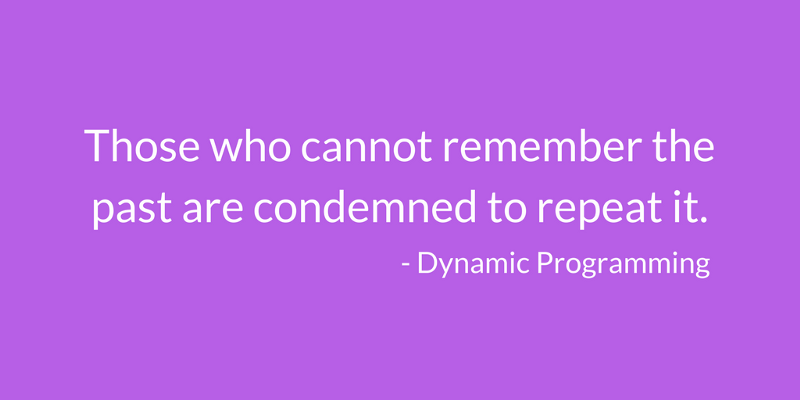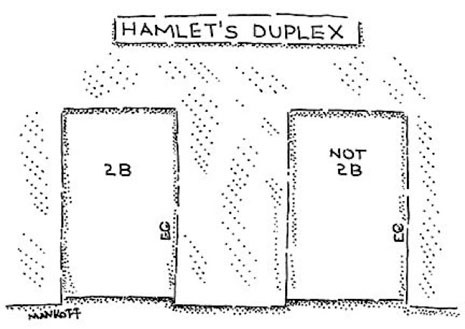How To Learn Dynamic Programming

past Alaina Kafkes
Demystifying Dynamic Programming
How to construct & code dynamic programming algorithms

Maybe y'all've heard near it in preparing for coding interviews. Perchance y'all've struggled through it in an algorithms course. Maybe you're trying to larn how to code on your ain, and were told somewhere forth the way that it's important to understand dynamic programming. Using dynamic programming (DP) to write algorithms is every bit essential as information technology is feared.
And who tin arraign those who shrink away from it? Dynamic programming seems intimidating considering it is ill-taught. Many tutorials focus on the outcome — explaining the algorithm, instead of the process — finding the algorithm . This encourages memorization, not understanding.
During my algorithms class this year, I pieced together my own process for solving problems that require dynamic programming. Parts of information technology come from my algorithms professor (to whom much credit is due!), and parts from my own dissection of dynamic programming algorithms.
Just before I share my process, let's showtime with the basics. What is dynamic programming, anyway?
Dynamic Programming Defined
Dynamic programming amounts to breaking down an optimization problem into simpler sub-bug, and storing the solution to each sub-trouble so that each sub-trouble is only solved one time.
To be honest, this definition may not make total sense until y'all see an example of a sub-problem. That'south okay, it'due south coming upward in the adjacent department.
What I hope to convey is that DP is a useful technique for optimization problems, those problems that seek the maximum or minimum solution given sure constraints, because it looks through all possible sub-problems and never recomputes the solution to any sub-trouble. This guarantees correctness and efficiency, which we cannot say of almost techniques used to solve or approximate algorithms. This lone makes DP special.
In the next two sections, I'll explicate what a sub-problem is, and and then motivate why storing solutions — a technique known as memoization — matters in dynamic programming.
Sub-problems on Sub-problems on Sub-problems
Sub-issues are smaller versions of the original problem. In fact, sub-problems oft expect like a reworded version of the original problem. If formulated correctly, sub-problems build on each other in club to obtain the solution to the original problem.
To requite you a improve idea of how this works, let's detect the sub-problem in an example dynamic programming trouble.
Pretend you're back in the 1950s working on an IBM-650 reckoner. You lot know what this ways — punchcards! Your job is to man, or adult female, the IBM-650 for a day. You're given a natural number north punchcards to run. Each punchcard i must exist run at some predetermined start fourth dimension s_i and stop running at some predetermined end fourth dimension f_i. Only 1 punchcard can run on the IBM-650 at once. Each punchcard also has an associated value v_i based on how of import it is to your visitor.
Problem: Equally the person in charge of the IBM-650, you must determine the optimal schedule of punchcards that maximizes the total value of all punchcards run.
Because I'll become through this example in nifty detail throughout this article, I'll only tease y'all with its sub-problem for now:
Sub-problem: The maximum value schedule for punchcards i through due north such that the punchcards are sorted by outset time.
Detect how the sub-trouble breaks down the original trouble into components that build up the solution. With the sub-problem, you can find the maximum value schedule for punchcards due north-1 through due north, and then for punchcards north-2 through n, and so on. By finding the solutions for every single sub-trouble, yous can and then tackle the original problem itself: the maximum value schedule for punchcards 1 through n. Since the sub-problem looks like the original problem, sub-issues can be used to solve the original trouble.
In dynamic programming, after you solve each sub-problem, you must memoize, or shop information technology. Let's observe out why in the following department.
Motivating Memoization with Fibonacci Numbers
When told to implement an algorithm that calculates the Fibonacci value for whatever given number, what would y'all do? Well-nigh people I know would opt for a recursive algorithm that looks something like this in Python:
def fibonacciVal(north): if n == 0: return 0 elif n == 1: render 1 else: render fibonacciVal(n-1) + fibonacciVal(n-ii) This algorithm accomplishes its purpose, but at a huge cost. For instance, let's expect at what this algorithm must calculate in order to solve for northward = five (abbreviated as F(5)):
F(v) / \ / \ / \ F(4) F(3) / \ / \ F(3) F(2) F(2) F(one) / \ / \ / \ F(ii) F(1) F(ane) F(0) F(one) F(0) / \ F(1) F(0) The tree above represents each ciphering that must be fabricated in guild to find the Fibonacci value for n = five. Notice how the sub-problem for n = 2 is solved thrice. For a relatively pocket-sized example (n = 5), that's a lot of repeated , and wasted, computation!
What if, instead of computing the Fibonacci value for n = ii three times, we created an algorithm that calculates it once, stores its value, and accesses the stored Fibonacci value for every subsequent occurrence of n = 2? That'southward exactly what memoization does.
With this in mind, I've written a dynamic programming solution to the Fibonacci value problem:
def fibonacciVal(n): memo = [0] * (north+1) memo[0], memo[1] = 0, 1 for i in range(2, n+1): memo[i] = memo[i-1] + memo[i-two] return memo[n] Detect how the solution of the return value comes from the memoization array memo[ ], which is iteratively filled in by the for loop. By "iteratively," I hateful that memo[ii] is calculated and stored before memo[3], memo[4], …, and memo[n]. Because memo[ ] is filled in this order, the solution for each sub-problem (n = 3) can be solved by the solutions to its preceding sub-problems (n = 2 and northward = 1) because these values were already stored in memo[ ] at an earlier time.
Memoization means no re-computation, which makes for a more efficient algorithm. Thus, memoization ensures that dynamic programming is efficient, but it is choosing the correct sub-trouble that guarantees that a dynamic program goes through all possibilities in order to find the best one.
Now that we've addressed memoization and sub-bug, it's time to acquire the dynamic programming process. Buckle in.
My Dynamic Programming Process
Step 1: Identify the sub-problem in words.
Too often, programmers will turn to writing code earlier thinking critically well-nigh the problem at hand. Not skilful. One strategy for firing up your brain earlier you lot touch on the keyboard is using words, English or otherwise, to describe the sub-trouble that you have identified inside the original problem.
If y'all're solving a problem that requires dynamic programming, catch a piece of newspaper and recall nigh the information that you need to solve this problem. Write out the sub-trouble with this in listen.
For example, in the punchcard problem, I stated that the sub-problem can be written as "the maximum value schedule for punchcards i through n such that the punchcards are sorted by start time." I found this sub-problem by realizing that, in guild to determine the maximum value schedule for punchcards 1 through due north such that the punchcards are sorted past commencement time, I would need to find the answer to the post-obit sub-bug:
- The maximum value schedule for punchcards north-1 through n such that the punchcards are sorted by start time
- The maximum value schedule for punchcards n-2 through due north such that the punchcards are sorted by start time
- The maximum value schedule for punchcards north-three through n such that the punchcards are sorted past offset fourth dimension
- (Et cetera)
- The maximum value schedule for punchcards 2 through n such that the punchcards are sorted past start time
If y'all can place a sub-problem that builds upon previous sub-problems to solve the problem at hand, so you're on the right track.
Step 2: Write out the sub-problem as a recurring mathematical decision.
In one case you lot've identified a sub-trouble in words, it's time to write it out mathematically. Why? Well, the mathematical recurrence, or repeated decision, that you notice will eventually be what yous put into your code. Besides, writing out the sub-problem mathematically vets your sub-problem in words from Step 1. If it is difficult to encode your sub-problem from Step 1 in math, and then it may be the wrong sub-problem!
In that location are ii questions that I ask myself every time I try to find a recurrence:
- What decision practice I make at every pace?
- If my algorithm is at stride i, what information would it demand to make up one's mind what to do in step i+1? (And sometimes: If my algorithm is at step i, what information did it need to decide what to practise in step i-1?)
Allow's return to the punchcard trouble and enquire these questions.
What conclusion practise I brand at every step? Assume that the punchcards are sorted by start fourth dimension, as mentioned previously. For each punchcard that is uniform with the schedule then far (its first fourth dimension is after the finish time of the punchcard that is currently running), the algorithm must choose between two options: to run, or not to run the punchcard.

If my algorithm is at step i, what data would it need to determine what to exercise in step i+i? To make up one's mind between the two options, the algorithm needs to know the next uniform punchcard in the guild. The next uniform punchcard for a given punchcard p is the punchcard q such that s_q (the predetermined start time for punchcard q) happens after f_p (the predetermined terminate time for punchcard p) and the difference betwixt s_q and f_p is minimized. Abandoning mathematician-speak, the next uniform punchcard is the one with the earliest starting time time after the electric current punchcard finishes running.
If my algorithm is at step i, what information did it need to determine what to do in pace i-1? The algorithm needs to know about hereafter decisions: the ones fabricated for punchcards i through due north in lodge to decide to run or non to run punchcard i-one.
At present that nosotros've answered these questions, perhaps you've started to form a recurring mathematical decision in your mind. If not, that's also okay, it becomes easier to write recurrences as you get exposed to more than dynamic programming bug.
Without further ado, here's our recurrence:
OPT(i) = max(v_i + OPT(adjacent[i]), OPT(i+1)) This mathematical recurrence requires some explaining, especially for those who haven't written 1 before. I utilize OPT(i) to represent the maximum value schedule for punchcards i through north such that the punchcards are sorted by kickoff time. Sounds familiar, right? OPT(•) is our sub-problem from Step 1.
In order to determine the value of OPT(i), we consider two options, and we want to take the maximum of these options in guild to run across our goal: the maximum value schedule for all punchcards. In one case we choose the option that gives the maximum outcome at step i, we memoize its value every bit OPT(i).
The two options — to run or not to run punchcard i — are represented mathematically as follows:
v_i + OPT(adjacent[i]) This clause represents the decision to run punchcard i. It adds the value gained from running punchcard i to OPT(adjacent[i]), where next[i] represents the next compatible punchcard following punchcard i. OPT(next[i]) gives the maximum value schedule for punchcards next[i] through n such that the punchcards are sorted past start fourth dimension. Adding these two values together produces maximum value schedule for punchcards i through n such that the punchcards are sorted by start time if punchcard i is run.
OPT(i+ane) Conversely, this clause represents the determination to not run punchcard i. If punchcard i is not run, its value is non gained. OPT(i+1) gives the maximum value schedule for punchcards i+1 through n such that the punchcards are sorted by commencement time. Then, OPT(i+i) gives the maximum value schedule for punchcards i through due north such that the punchcards are sorted past start time if punchcard i is not run.
In this way, the decision made at each pace of the punchcard problems is encoded mathematically to reflect the sub-problem in Step 1.
Step 3: Solve the original trouble using Steps 1 and 2.
In Step 1, we wrote downward the sub-problem for the punchcard trouble in words. In Footstep 2, nosotros wrote down a recurring mathematical determination that corresponds to these sub-problems. How can we solve the original problem with this information?
OPT(1) Information technology's that elementary. Since the sub-problem we found in Step i is the maximum value schedule for punchcards i through n such that the punchcards are sorted past first time, we tin can write out the solution to the original problem as the maximum value schedule for punchcards 1 through north such that the punchcards are sorted by start time. Since Steps 1 and 2 go hand in hand, the original trouble can also exist written equally OPT(1).
Step 4: Determine the dimensions of the memoization array and the direction in which information technology should be filled.
Did you notice Stride 3 deceptively simple? It certain seems that manner. You may be thinking, how tin can OPT(ane) be the solution to our dynamic programme if it relies on OPT(two), OPT(side by side[ane]), and so on?
Yous're correct to observe that OPT(i) relies on the solution to OPT(2). This follows directly from Stride 2:
OPT(1) = max(v_1 + OPT(next[one]), OPT(ii)) Only this is not a burdensome issue. Think dorsum to Fibonacci memoization example. To notice the Fibonacci value for n = 5, the algorithm relies on the fact that the Fibonacci values for n = 4, n = 3, n = 2, due north = 1, and n = 0 were already memoized. If nosotros fill in our memoization table in the right order, the reliance of OPT(one) on other sub-problems is no big deal.
How tin we place the correct management to fill the memoization tabular array? In the punchcard problem, since we know OPT(one) relies on the solutions to OPT(2) and OPT(side by side[1]), and that punchcards 2 and next[1] have get-go times after punchcard one due to sorting, nosotros can infer that we demand to fill our memoization table from OPT(n) to OPT(1).
How do we determine the dimensions of this memoization array? Hither'southward a trick: the dimensions of the assortment are equal to the number and size of the variables on which OPT(•) relies. In the punchcard problem, we have OPT(i), which means that OPT(•) only relies on variable i, which represents the punchcard number. This propose that our memoization assortment will be one-dimensional and that its size will be n since in that location are n total punchcards.
If we know that due north = 5, and so our memoization array might look like this:
memo = [OPT(1), OPT(2), OPT(3), OPT(4), OPT(5)] However, because many programming languages get-go indexing arrays at 0, information technology may exist more user-friendly to create this memoization array then that its indices align with punchcard numbers:
memo = [0, OPT(1), OPT(2), OPT(iii), OPT(4), OPT(v)] Footstep 5: Code it!
To code our dynamic program, we put together Steps 2–4. The only new piece of information that y'all'll need to write a dynamic program is a base case, which you can find as y'all tinker with your algorithm.
A dynamic program for the punchcard problem will look something like this:
def punchcardSchedule(due north, values, adjacent): # Initialize memoization assortment - Stride 4 memo = [0] * (n+1) # Prepare base of operations case memo[n] = values[n] # Build memoization table from n to 1 - Footstep 2 for i in range(n-1, 0, -1): memo[i] = max(v_i + memo[next[i]], memo[i+1]) # Return solution to original problem OPT(1) - Footstep iii return memo[1] Congrats on writing your first dynamic program! Now that you've wet your feet, I'll walk yous through a different type of dynamic program.
Paradox of Choice: Multiple Options DP Example

Although the previous dynamic programming example had a 2-option decision — to run or not to run a punchcard — some bug require that multiple options be considered before a decision can exist made at each pace.
Time for a new case.
Pretend y'all're selling the friendship bracelets to n customers, and the value of that product increases monotonically. This means that the product has prices {p_1, …, p_n} such that p_i ≤ p_j if customer j comes after client i. These northward customers have values {v_1, …, v_n}. A given customer i volition buy a friendship bracelet at toll p_i if and only if p_i ≤ v_i; otherwise the revenue obtained from that customer is 0. Assume prices are natural numbers.
Problem: Yous must find the set up of prices that ensure yous the maximum possible revenue from selling your friendship bracelets.
Take a second to think nigh how you might address this problem earlier looking at my solutions to Steps 1 and 2.
Pace 1: Identify the sub-problem in words.
Sub-problem: The maximum revenue obtained from customers i through northward such that the cost for client i-1 was set at q.
I institute this sub-problem by realizing that to determine the maximum revenue for customers i through n, I would demand to detect the answer to the following sub-bug:
- The maximum revenue obtained from customers n-1 through n such that the price for customer n-2 was set at q.
- The maximum revenue obtained from customers n-2 through n such that the price for client n-3 was prepare at q.
- (Et cetera)
Notice that I introduced a second variable q into the sub-problem. I did this because, in order to solve each sub-problem, I need to know the cost I set for the customer before that sub-trouble. Variable q ensures the monotonic nature of the fix of prices, and variable i keeps track of the current customer.
Step 2: Write out the sub-trouble as a recurring mathematical determination.
There are ii questions that I ask myself every time I endeavour to find a recurrence:
- What conclusion practice I make at every step?
- If my algorithm is at step i, what information would information technology demand to decide what to exercise in stride i+1? (And sometimes: If my algorithm is at pace i, what information would it need to decide what to do in pace i-one?)
Let's return to the friendship bracelet trouble and ask these questions.
What decision do I make at every step? I decide at which toll to sell my friendship bracelet to the current client. Since prices must exist natural numbers, I know that I should fix my price for customer i in the range from q — the cost set for customer i-1 — to v_i — the maximum toll at which customer i volition purchase a friendship bracelet.
If my algorithm is at step i, what data would it need to determine what to exercise in step i+1? My algorithm needs to know the price set up for customer i and the value of customer i+i in order to decide at what natural number to set the price for customer i+1.
With this noesis, I can mathematically write out the recurrence:
OPT(i,q) = max~([Acquirement(v_i, a) + OPT(i+i, a)]) such that max~ finds the maximum over all a in the range q ≤ a ≤ v_i In one case over again, this mathematical recurrence requires some explaining. Since the price for customer i-i is q, for customer i, the price a either stays at integer q or information technology changes to be some integer between q+1 and v_i. To find the full revenue, we add the revenue from customer i to the maximum revenue obtained from customers i+1 through n such that the price for client i was set at a.
In other words, to maximize the total revenue, the algorithm must observe the optimal price for client i by checking all possible prices between q and v_i. If v_i ≤ q, then the price a must remain at q.
What about the other steps?
Working through Steps ane and 2 is the most hard part of dynamic programming. As an exercise, I propose you piece of work through Steps 3, 4, and v on your own to check your understanding.
Runtime Analysis of Dynamic Programs
Now for the fun part of writing algorithms: runtime assay. I'll be using big-O annotation throughout this word . If you lot're not yet familiar with big-O, I advise y'all read upwards on it here.
Generally, a dynamic program's runtime is composed of the following features:
- Pre-processing
- How many times the for loop runs
- How much fourth dimension it takes the recurrence to run in one for loop iteration
- Post-processing
Overall, runtime takes the following form:
Pre-processing + Loop * Recurrence + Mail-processing Let'southward perform a runtime assay of the punchcard problem to go familiar with big-O for dynamic programs. Here is the punchcard trouble dynamic program:
def punchcardSchedule(due north, values, side by side): # Initialize memoization array - Step 4 memo = [0] * (due north+ane) # Set up base of operations case memo[n] = values[north] # Build memoization table from north to 1 - Pace 2 for i in range(northward-i, 0, -1): memo[i] = max(v_i + memo[next[i]], memo[i+i]) # Return solution to original problem OPT(ane) - Stride 3 return memo[1] Let's break downwards its runtime:
- Pre-processing: Hither, this means edifice the the memoization assortment. O(n).
- How many times the for loop runs: O(n).
- How much time it takes the recurrence to run in ane for loop iteration: The recurrence takes constant time to run because it makes a decision between two options in each iteration. O(1).
- Postal service-processing: None here! O(1).
The overall runtime of the punchcard problem dynamic programme is O(n) O(n) * O(1) + O(ane), or, in simplified grade, O(northward).
You Did Information technology!
Well, that's information technology — y'all're one step closer to becoming a dynamic programming sorcerer!

One final slice of wisdom: keep practicing dynamic programming. No matter how frustrating these algorithms may seem, repeatedly writing dynamic programs will make the sub-bug and recurrences come to yous more naturally. Here's a crowdsourced listing of classic dynamic programming issues for you to endeavour.
So get out there and take your interviews, classes, and life (of course) with your newfound dynamic programming noesis!
Many cheers to Steven Bennett, Claire Durand, and Prithaj Nath for proofreading this post. Thanks to Professor Hartline for getting me so excited about dynamic programming that I wrote well-nigh it at length.
Savour what you read? Spread the love by liking and sharing this slice. Have thoughts or questions? Accomplish out to me on Twitter or in the comments beneath.
Learn to code for costless. freeCodeCamp's open source curriculum has helped more than 40,000 people get jobs every bit developers. Get started
Source: https://www.freecodecamp.org/news/demystifying-dynamic-programming-3efafb8d4296/
Posted by: sosakinge1950.blogspot.com


0 Response to "How To Learn Dynamic Programming"
Post a Comment